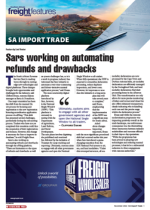There’s been a significant shift in South Africa's trade balance in the year-to-date preliminary numbers, with the trade surplus taking a hit when compared to the same period in 2022. Figures reveal a trade balance surplus of R32.0 billion for the period from January 1 to August 31, 2023, marking a stark deterioration from the R160.5bn surplus recorded in the comparable period last year.This decline in the trade balance surplus is partly attributed to the recent dynamics in import f lows. In August 2023, imports showed a marginal decrease of 0.1% year-on-year, declining from R168.2bn in August 2022 to R168.0bn during the current period. However, on a month-to-month basis, there was a notable increase of R10.0bn in imports, marking a 6.3% surge from R158.0bn in July to R168.0bn in August this year.The composition of South Africa's imports, especially the top five source countries, is an essential aspect of this trade balance equation. China remains the largest contributor to South Africa's imports, accounting for a significant 19.1% of the total imports. Germany follows closely at 9.6%, while India and the United States contribute 9.4% and 8.7%, respectively. Thailand holds the fifth position with a 3.6% share of South Africa's imports.Of particular interest is the noticeable increase in import values, primarily driven by substantial surges in the importation of fertilisers, original equipment components, and passenger vehicles. This surge in imports ref lects both increased consumer and industrial demands in South Africa, as well as potential shifts in the nation's supply chain dynamics.

